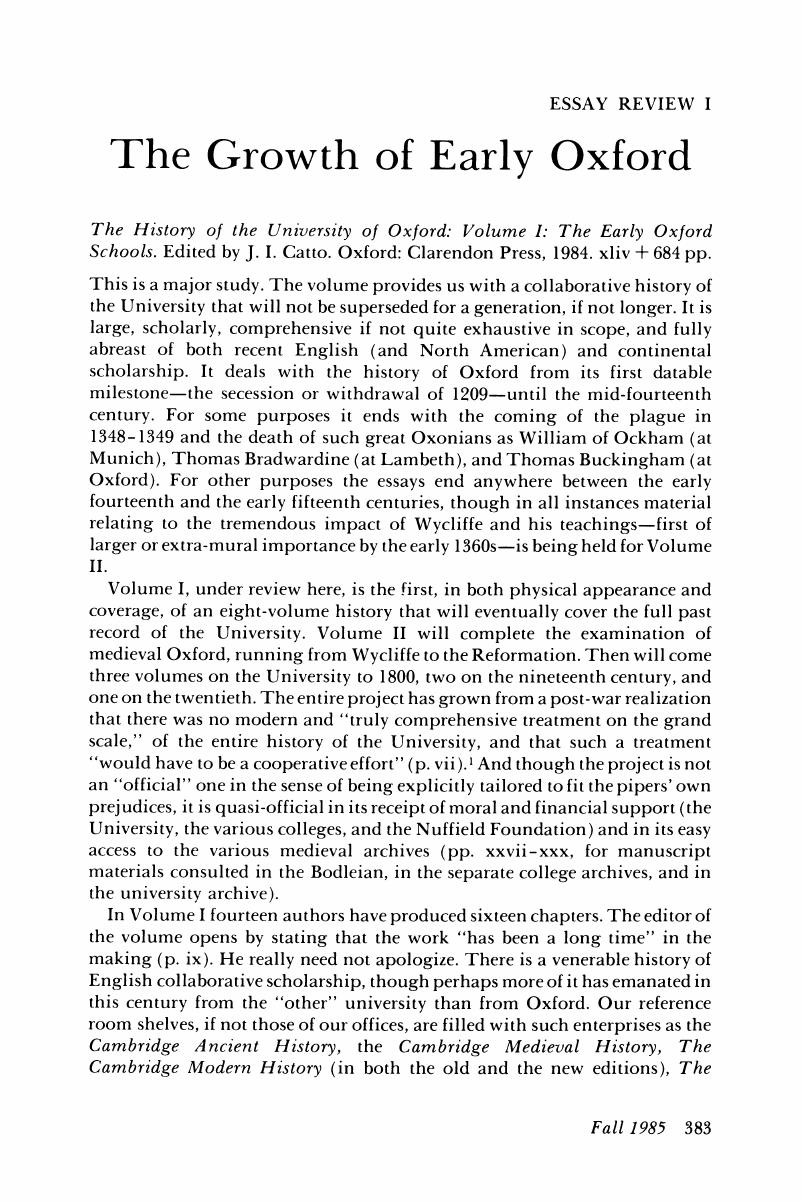No CrossRef data available.
Article contents
The Growth of Early Oxford
Published online by Cambridge University Press: 24 February 2017
Abstract

- Type
- Essay Reviews
- Information
- Copyright
- Copyright © 1985 by History of Education Society
References
Notes
1. Aston, T. H., as general editor of the project, discusses the inception of the whole affair (pp. v–viii), as well as some of its predecessors, from J. Harclay's fourteenth-century Historiola through the scholarship of the 1970s. The current project was launched in 1968, with Lord Bullock as its prime mover.Google Scholar
2. From the letter to the contributors to the Cambridge Modern History, as quoted in Stern, Fritz, The Varieties of History (New York, 1973), 248–249.Google Scholar
3. Lineham, P. A., “The Making of the Cambridge Medieval History,” Speculum, 57 (1982):463–494. In Vol. 1 (1911) the editors, Gwatkin, H. M. and Whitney, J. P., spoke of how “it is hoped to publish two volumes yearly in regular succession” (p. vi). When Vol. 8 appeared (in 1936) to end the series, Previte-Orton, C. W. and Brooke, Z. N. referred to five of their authors who had not lived to see the volume in print, and they admitted that “it is not without a sigh of relief that they sign their initials for the last time” (p. v). For a poignant reminder of the difficulties of collaborative scholarship in a troubled world, Cambridge Economic History of Europe, Vol. 1, ed., Clapham, J. H. and Power, E. (Cambridge, 1941), pp. v–viii.CrossRefGoogle Scholar
4. Emden, A. B., Biographical Register of the University of Oxford to A.D. 1500 (Oxford, 3 vols., 1957–59). Also, his Biographical Register of the University of Oxford, A.D. 1501 to 1540 (Oxford, 1974), a volume that no doubt will figure in the second volume of the collaborative history. For an analysis of personnel based largely on Emden's biographical registers, Aston, T. A., “Oxford's Medieval Alumni,” Past and Present, 74 (1977):3–40. For a discussion of this work, and some critical suggestions, Burson, Malcolm, “Emden's Registers and the prosopography of medieval English universities,” Medieval Prosopography, Autumn, 1982 (3, ii):35–51. For a survey of recent work, Rosenthal, J. T., “English medieval education since 1970—so near and yet so far,” History of Education Quarterly, Vol. 22, n. 4 (Winter, 1982):499–511.Google Scholar
5. Rashdall, Hastings, The Universities of Europe in the Middle Ages, Vol. 3, edited and revised, Emden, A. B. and Powicke, F. M., Oxford, 1936. Oxford University is covered in chapters 1–7 (pp. 1–273). Rashdall's first edition appeared in 1895. One study that has since attempted a similar comprehensive treatment is Mallet, Charles E., A History of the University of Oxford, Oxford, 1924, Vol. 1.Google Scholar
6. When Rashdall published in 1895 the Oxford Historical Society had produced 30 volumes: since then, a further 71 have appeared in the original series and, through 1981, another 28 in the new series. Emden and Powicke discuss other scholarly contributions that have made their revision possible (pp. xxx and p. 3 of Vol. 3 of their 1936 edition). A series of high quality though popular histories of the colleges was begun by Robinson's in 1898, and today Vol. 3 of the Victorian County History of Oxfordshire contains capsule college histories: none of this was available when Rashdall wrote his third volume.Google Scholar
7. Though for reasons that have more to do with space and the proliferation of modern scholarship than to cost, the editors of one recent Cambridge collaborative history came to the same decision: Clark, G. N., “General introduction: history and the modern historian,” The New Cambridge Modern History, Cambridge, 1957, I, xxxvi.Google Scholar
8. As an indication of current interest in Grosseteste, there are at least three current editorial projects under the auspices of the Medieval Texts Editorial Committee of the British Academy (chaired by Southern, R. W.): the De Cessatione Legalium, ed., Dale, R. C.; the Decem Mandatis , ed., Dale, and King, E.; the Dicta: Proceedings of the British Academy, lxvii (1982), 66.Google Scholar




